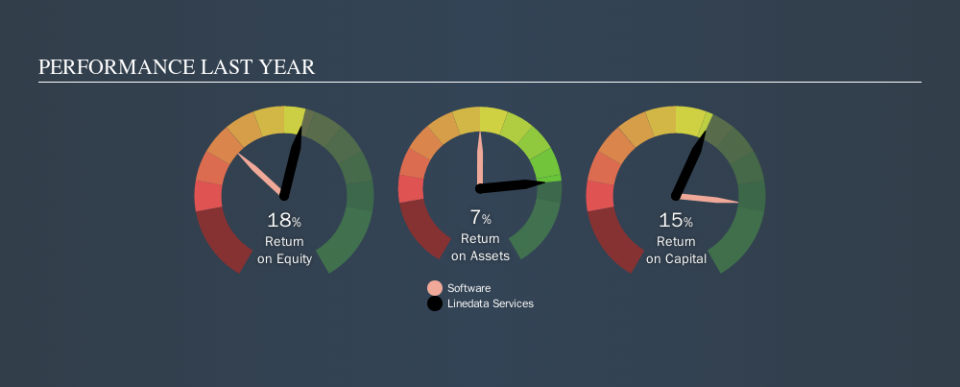Linedata Services S.A. (EPA:LIN) Earns A Nice Return On Capital Employed

Today we'll look at Linedata Services S.A. (EPA:LIN) and reflect on its potential as an investment. In particular, we'll consider its Return On Capital Employed (ROCE), as that can give us insight into how profitably the company is able to employ capital in its business.
First up, we'll look at what ROCE is and how we calculate it. Then we'll compare its ROCE to similar companies. Last but not least, we'll look at what impact its current liabilities have on its ROCE.
What is Return On Capital Employed (ROCE)?
ROCE is a metric for evaluating how much pre-tax income (in percentage terms) a company earns on the capital invested in its business. All else being equal, a better business will have a higher ROCE. In brief, it is a useful tool, but it is not without drawbacks. Renowned investment researcher Michael Mauboussin has suggested that a high ROCE can indicate that 'one dollar invested in the company generates value of more than one dollar'.
How Do You Calculate Return On Capital Employed?
Analysts use this formula to calculate return on capital employed:
Return on Capital Employed = Earnings Before Interest and Tax (EBIT) ÷ (Total Assets - Current Liabilities)
Or for Linedata Services:
0.15 = €33m ÷ (€304m - €86m) (Based on the trailing twelve months to June 2019.)
So, Linedata Services has an ROCE of 15%.
View our latest analysis for Linedata Services
Is Linedata Services's ROCE Good?
One way to assess ROCE is to compare similar companies. Using our data, we find that Linedata Services's ROCE is meaningfully better than the 9.1% average in the Software industry. I think that's good to see, since it implies the company is better than other companies at making the most of its capital. Separate from Linedata Services's performance relative to its industry, its ROCE in absolute terms looks satisfactory, and it may be worth researching in more depth.
We can see that, Linedata Services currently has an ROCE of 15%, less than the 24% it reported 3 years ago. Therefore we wonder if the company is facing new headwinds. The image below shows how Linedata Services's ROCE compares to its industry, and you can click it to see more detail on its past growth.
When considering ROCE, bear in mind that it reflects the past and does not necessarily predict the future. Companies in cyclical industries can be difficult to understand using ROCE, as returns typically look high during boom times, and low during busts. This is because ROCE only looks at one year, instead of considering returns across a whole cycle. Future performance is what matters, and you can see analyst predictions in our free report on analyst forecasts for the company.
Linedata Services's Current Liabilities And Their Impact On Its ROCE
Current liabilities are short term bills and invoices that need to be paid in 12 months or less. The ROCE equation subtracts current liabilities from capital employed, so a company with a lot of current liabilities appears to have less capital employed, and a higher ROCE than otherwise. To check the impact of this, we calculate if a company has high current liabilities relative to its total assets.
Linedata Services has total liabilities of €86m and total assets of €304m. Therefore its current liabilities are equivalent to approximately 28% of its total assets. A fairly low level of current liabilities is not influencing the ROCE too much.
The Bottom Line On Linedata Services's ROCE
This is good to see, and with a sound ROCE, Linedata Services could be worth a closer look. Linedata Services looks strong on this analysis, but there are plenty of other companies that could be a good opportunity . Here is a free list of companies growing earnings rapidly.
If you like to buy stocks alongside management, then you might just love this free list of companies. (Hint: insiders have been buying them).
We aim to bring you long-term focused research analysis driven by fundamental data. Note that our analysis may not factor in the latest price-sensitive company announcements or qualitative material.
If you spot an error that warrants correction, please contact the editor at editorial-team@simplywallst.com. This article by Simply Wall St is general in nature. It does not constitute a recommendation to buy or sell any stock, and does not take account of your objectives, or your financial situation. Simply Wall St has no position in the stocks mentioned. Thank you for reading.


